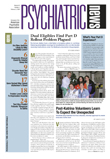Polypharmacy—a term that leaves many clinicians and patients queasy—is often the rule in treating bipolar illness, yet the consequences of using more than one drug or switching between drugs are often unexamined, said psychiatrist Arthur Lazarus, M.D., M.B.A., at the annual meeting of the American Public Health Association in Philadelphia in December.
Lazarus and seven colleagues conducted a retrospective cohort study of patients with bipolar diagnoses seen at the Henry Ford Health System in Michigan and found that more than one-third had histories of switching prescriptions or receiving concomitant prescriptions. Patients prescribed at least two psychotropic medications were more likely to be hospitalized or visit the emergency room, they found. Black patients were more likely to receive at least two psychotropic medications and more likely to go to emergency departments or hospitals, compared with non-black patients. They were also more likely to be diagnosed with Axis I psychiatric disorders, to be female, and to be eligible for Medicaid, compared with non-blacks.
“I think these results demonstrate the need for more research and re-examination of treatment guidelines for bipolar disorder,” said Lazarus, senior director for neuroscience clinical research at AstraZeneca.
The need for more than one drug should not be surprising, given the need to treat different phases of bipolar disorder and to stabilize mood. Only one combination drug, composed of an existing antidepressant and antipsychotic, is now approved by the Food and Drug Administration, said Lazarus in an interview.
The researchers examined records covering continuous enrollment from one year prior to the date of the index prescription to one year after that date. Patients had to be at least 19 years old, meet criteria for bipolar disorder in the International Classification of Diseases, Ninth Revision (ICD-9), and have at least one prescription for drugs in four classes: anticonvulsants, mood stabilizers, first-generation antipsychotics, and second-generation antipsychotics.
The 1,113 patients included in the study averaged 44.3 years old. About 61 percent were women, 29 percent were black, 68 percent were white, and 2.5 percent were listed as “other” by race. Patients were stratified into black and non-black categories. Approximately one-third had cardiovascular morbidities, and 13 percent were substance abusers. Many of these patients had previously received other psychiatric diagnoses, which may indicate a high rate of misdiagnosis of bipolar disorder, said Lazarus.
About 10 percent of all patients received drugs in at least two of the four medication classes at the index date, and 36.6 percent received two or more psychotropic drugs during follow-up. However, there were statistically significant racial differences in prescribing patterns. About 12.6 percent of black patients and 8.5 percent of non-black patients received at least two drugs at the index date, and 41.1 percent of black patients and 34.7 percent of non-black patient got at least two drugs at any time.
Almost half the patients (44.2 percent) had at least one emergency department visit or hospitalization in the first year of follow-up. However, patients on multiple drug regimens were more likely to be seen in those settings than those on one or no drugs.
More than half (53.1 percent) of black patients had a hospitalization/emergency department visit during the first year's follow-up, compared with 40.5 percent of non-black patients (p<0.001). The mean total health care costs of $11,836 per patient in the year following index date did not differ by race.
The findings may indicate that patients on two or more drugs had more severe illness and that the greater number of prescriptions was an appropriate response to that severity, said Lazarus. In contrast, they may also reflect more familiar health care disparities. The study did find that black patients were more likely to get prescriptions from emergency room physicians, an indication that they lack regular providers and continuity of care.
Currently, said Lazarus, several differing guidelines address the care of patients with bipolar disorder, which may cause confusion or undertreatment.“ We need to develop practical guidelines that both physicians and patients can adhere to,” said Lazarus.
A full version of Lazarus's APHA talk has been accepted for publication by Psychiatric Services and is scheduled for publication later this year. ▪
